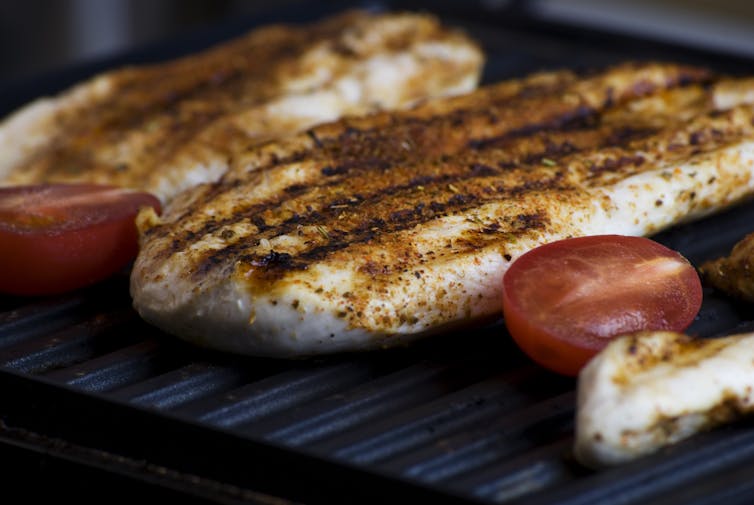Food safety authorities and regulators around the world recommend you don’t wash raw poultry before cooking. That’s because washing chicken can splash dangerous bacteria around the kitchen. It’s best just to thoroughly cook the chicken without washing it, so it is safe to eat.
Despite this, chicken washing remains common. A survey by Australia’s Food Safety Information Council showed almost half of Australian home cooks washed whole chickens before cooking. Dutch research found 25 percent of consumers washed it often or almost always. So why do people do it — and what does the research say about the risks of chicken washing?

Chicken meat and germs
Incorrect cooking temperatures and cross-contamination between different foods are two of the most important factors linked to foodborne illness. This is particularly relevant to poultry meat. Two leading causes of foodborne illness are the bacteria Campylobacter and Salmonella, which are commonly found on raw poultry. In Australia, reported cases of Campylobacter and Salmonella have almost doubled over the last two decades. Of the estimated 220,000 cases of Campylobacter infection each year, 50,000 can be attributed either directly or indirectly to chicken meat.

Chicken washing myths, busted
One analysis of consumer responses to an education campaign about the dangers of washing raw poultry shed light on why many people still wash raw chicken before cooking. Some believe there is a need to wash feces and other matter off the meat. In fact, modern processing techniques mean the carcasses do not need additional cleaning. Others believe washing with a slightly acidic solution (such as vinegar or lemon juice) will kill bacteria. On the contrary, research has shown washing raw poultry in lemon juice or vinegar does not remove bacteria and can increase the cross-contamination risk.
Washing chicken splashes bacteria around
One of the more compelling arguments why washing raw poultry under a running tap is a risky activity comes from recent research on water droplets ejected from the surface of washed chicken. The study clearly showed bacteria can be transferred from the surface of the meat to surrounding surfaces via water droplets. Using high-speed imaging, the researchers found a higher tap height can increase splashing.
The meat is often soft and the water flow can create a divot in the surface. This leads to splashing that would not occur on a curved, hard surface. The researchers placed large agar plates next to the chicken surfaces to capture any water droplets. This allowed them to grow the bacteria that were transferred with the splashed water. They found the level of bacterial transmission increased with greater tap height and water flow rate. Aerated water (which is what you get when the tap is running very hard) also increased splashing and bacterial transmission.
What if I still really want to wash my chicken meat?
While washing raw poultry is not recommended, it appears some home cooks are reluctant to let go of this old habit. If you insist on washing chicken meat, consider doing so in a sink of water rather than under a running tap. Use a paper towel to mop up any liquids, dispose of the towel and clean up afterward. This will help reduce the risk of cross-contamination and keep the kitchen safe. And please wash your hands after handling raw meat!
This article is republished from The Conversation under a Creative Commons license. Read the original article.
Author: Enzo Palombo, Professor of Microbiology, Swinburne University of Technology
Follow us on Twitter, Facebook, or Pinterest

